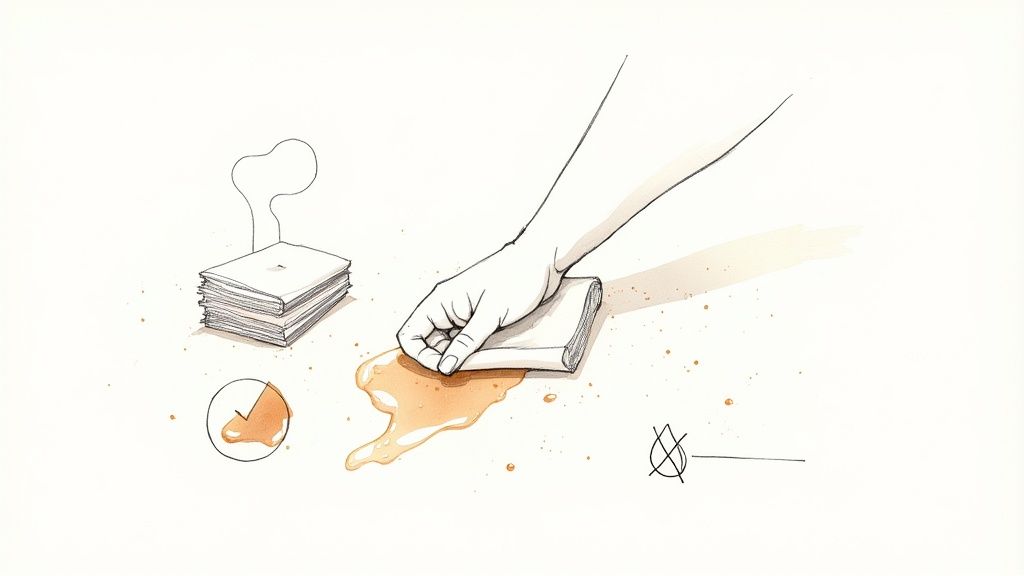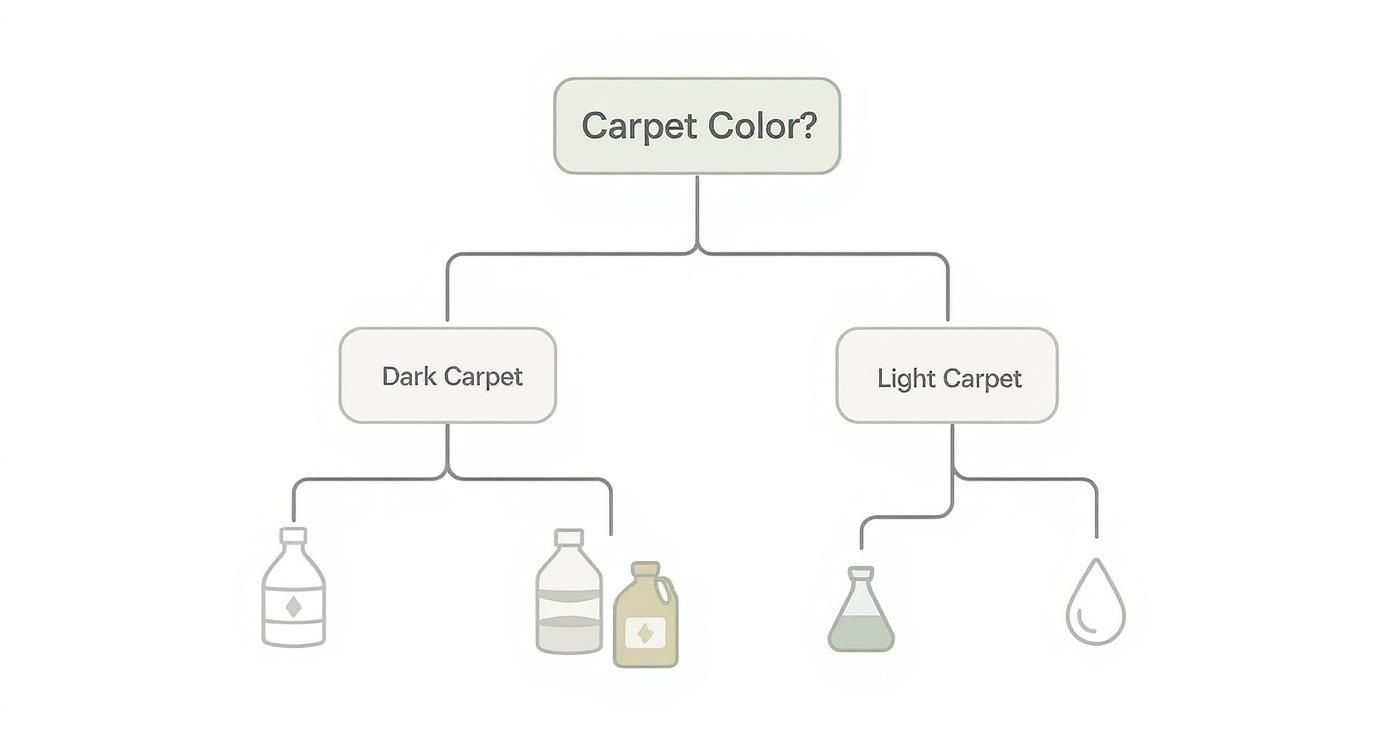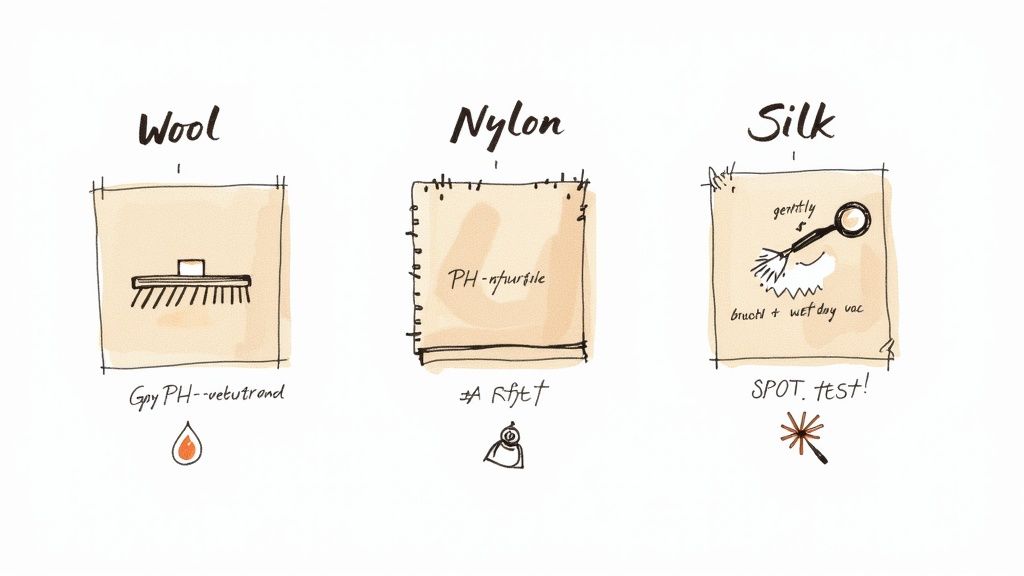It's that heart-dropping moment when a full mug of coffee takes a nosedive onto your beautiful carpet. We’ve all been there. But here’s the good news: a permanent stain isn’t inevitable if you act fast. The absolute best way to get out a coffee stain from carpet is to grab a cloth and start blotting immediately before that spill has a chance to settle in. Seriously, this one move is your biggest weapon against a lasting mark.
Your First Move After a Coffee Spill
When coffee hits the carpet, the clock starts ticking. Fast. The tannins in coffee—the stuff that gives it that beautiful, rich color—are eager to dye your carpet fibers. Letting a spill sit for even a few minutes makes it dramatically harder to get out.
Immediate Action Checklist for Coffee Spills
When a spill happens, panic can set in. Use this quick table as your go-to guide for those critical first moments.
| Action Item | Why It's Important | Materials Needed |
|---|---|---|
| Grab a Dry Cloth | Speed is everything. You need to soak up the excess liquid right away. | Clean, white towel or paper towels |
| Blot from the Outside In | This prevents the stain from spreading and becoming a bigger problem. | Gentle, dabbing motions |
| Apply Gentle Pressure | Helps pull the coffee up out of the carpet fibers and into the cloth. | Your hands or body weight |
| Check Your Cloth | Keep turning to a clean, dry section to maximize absorption. | Multiple cloths if needed |
Following these steps stops the stain in its tracks and makes the rest of the cleaning process much easier.

Blot, Don't Rub
Your first instinct might be to scrub like mad. Don't do it! Rubbing is the worst thing you can do. It grinds the coffee deeper into the carpet pile, spreads the stain, and can even damage the fibers, leaving a permanent fuzzy spot.
Instead, take a clean, white cloth and gently blot the spill. Work from the outer edge of the stain toward the center. This technique contains the mess and pulls the liquid up and out of the carpet.
Pro Tip: Always, always use a white cloth. I’ve seen it happen—a colored towel or printed napkin can transfer its dye right onto your carpet, leaving you with a brand new, even tougher stain to deal with.
Common Mistakes to Avoid
In the heat of the moment, it's easy to make a wrong move that locks in the stain for good. Here are a few things to steer clear of:
- Don't use hot water. Heat will chemically set the coffee tannins into the fibers, almost like a dye. Stick with cool or lukewarm water.
- Avoid colored soaps. Many bar soaps or detergents have dyes that can leave a colored residue behind. If you need a cleaner, go for a clear, mild dish soap.
- Don't oversaturate the area. Drenching the carpet with too much water can soak the padding underneath, which is a recipe for mildew and lingering odors. Less is more.
Sometimes a spill is just too big to handle on your own. For massive liquid messes that go way beyond a coffee cup, check out your guide to emergency water cleanup for more in-depth advice. For most everyday spills, mastering the blot is your ticket to success. We cover more of these techniques in our guide on the best way to get spots out of carpet.
Tackling Old, Set-In Coffee Stains
Finding a coffee stain that’s had hours—or even days—to dry can feel like a real lost cause. Once coffee dries, its tannins have had time to bond with the carpet fibers, which makes it way more stubborn than a fresh spill. But don't throw in the towel just yet; you just need to bring out the bigger guns.
Simple soap and water aren’t going to cut it here. For a stain that’s already set, your chances of getting it out with basic methods drop dramatically. In fact, some research suggests you've only got about a 40% success rate with simple cleaners on old marks. You can dig into more insights on stain removal at askteamclean.com.
Create a DIY Cleaning Paste
One of my favorite homemade solutions for an old coffee stain is a simple paste made from baking soda and white vinegar. It’s the fizzing chemical reaction that does the heavy lifting, breaking down those hardened stain particles and pulling them up from deep in the carpet.
- Mix the Paste: Grab a small bowl and mix a few tablespoons of baking soda with just enough white vinegar to form a thick, spreadable paste.
- Apply to the Stain: Gently work the paste right into the stained fibers. You can use your fingers or the back of a spoon. You should see it start to bubble and fizz right away.
- Let it Work: Now, just let the paste sit until it dries completely on the stain. This could take a few hours, so be patient.
- Vacuum it Up: Once it’s totally dry and crusty, use your vacuum to suck up all the dried residue.
This method works so well because it attacks the stain without completely oversaturating your carpet with liquid. If you're dealing with other stubborn spots, you might find our guide on removing set-in carpet stains useful.
A quick word of caution: Before you go all-in with any new cleaning solution, always test it on a hidden spot first. Think inside a closet or under the sofa. This little step ensures the solution won’t accidentally discolor or damage your carpet fibers.
Using Hydrogen Peroxide on Light Carpets
If you’ve got a light-colored or white carpet, a diluted hydrogen peroxide solution can work wonders. It acts as a gentle bleaching agent to lift the last little bit of a stubborn coffee stain. But be warned: Never use this on dark or colored carpets. It can and will cause permanent discoloration.
To give this a try, just mix one part 3% hydrogen peroxide with two parts water. Lightly dab the solution onto the stain using a clean, white cloth. Let it sit for about an hour, then come back and blot the area with a water-dampened cloth to rinse it out before blotting it dry.
Choosing Your Cleaning Solution: DIY vs. Commercial
When you're staring down a fresh coffee stain, the big question is always what to use on it. Do you grab the white vinegar from the pantry or reach for a specialized cleaner under the sink? Honestly, both have their place. The right choice really depends on how old the stain is, what your carpet is made of, and frankly, what you're comfortable with.
Homemade remedies are often the first line of defense for a reason. They're cheap, you probably already have the ingredients, and they’re generally safer if you have curious pets or little ones crawling around. For a brand new, minor spill, a simple mix of vinegar and water can work wonders.
But for those stubborn, set-in stains? That's when you might need to bring out the big guns. This is where commercial cleaners really shine.
When to Go Commercial
Store-bought products are engineered to break down tough organic compounds, like the tannins that give coffee its dark color. When you're shopping, you’ll want to look for cleaners that are either enzymatic or oxygen-based.
- Enzymatic Cleaners: These use special proteins to chemically break down the stain. Think of them as Pac-Man for your carpet—they literally eat away at the coffee, milk, and sugar molecules.
- Oxygen-Based Cleaners: Products like OxiClean use a chemical reaction that lifts the stain right out of the carpet fibers, making it much easier to blot up and remove for good.
These cleaners are especially good for old, dried-on stains that a simple vinegar solution just can’t seem to touch. The trade-off is that they cost a bit more and can contain stronger chemicals, so always—always—read the label and test it on a hidden spot first.
To help you decide, here’s a quick breakdown of the pros and cons for each approach.
DIY vs. Commercial Carpet Cleaners for Coffee Stains
| Factor | DIY Solutions (Vinegar, Baking Soda) | Commercial Cleaners (Enzymatic, Oxygen-Based) |
|---|---|---|
| Best For | Fresh, minor spills; natural fiber carpets | Old, set-in stains; stubborn discoloration |
| Cost | Very low; uses common household items | Moderate to high; requires a specific purchase |
| Effectiveness | Good on new stains, may struggle with old ones | Highly effective on tough, organic stains |
| Safety | Generally safe for pets and kids; non-toxic | May contain harsh chemicals; requires good ventilation |
| Convenience | Ingredients are usually already on hand | Requires a trip to the store |
Ultimately, choosing between a DIY mix and a store-bought product comes down to balancing cost and convenience with some serious cleaning power. For a quick, eco-friendly fix on a fresh spill, DIY is a great place to start. For a dried, deep-set stain, a good commercial cleaner is a worthwhile investment.
This decision tree gives you a quick visual guide for dealing with an older coffee stain, factoring in your carpet's color.

As you can see, sometimes a simple homemade solution is the safest bet, especially on dark carpets where you don't want to risk discoloration. But for lighter carpets where every last trace of the stain will show, a specialized cleaner might be your only option.
Making the Right Choice
At the end of the day, knowing how to get out coffee stain from carpet means having a few different tools in your cleaning arsenal. The surprising effectiveness of a simple paste is a perfect example of why it's so useful to understand the power of baking soda to remove stains from carpets. It's a fantastic, cheap option for all sorts of common household spills.
Think of it this way: a vinegar solution is like a first-aid kit for your carpet—perfect for immediate, minor incidents. A powerful enzymatic cleaner is like calling in a specialist for a more serious problem. Having both on hand means you're ready for any coffee catastrophe that comes your way.
Cleaning Methods for Different Carpet Types
You wouldn't use the same cleaner on a silk shirt and a pair of denim jeans, right? The same logic applies to your carpet. Using the wrong cleaning method can turn a simple coffee spill into a permanent, ugly stain. What works like a charm on a tough synthetic carpet could absolutely ruin delicate natural fibers like wool. You’ve got to match your attack plan to your carpet type.

Most homes have synthetic carpets, like nylon or polyester, and the good news is they’re pretty tough. These can usually handle a slightly more aggressive approach. A simple mix of white vinegar and water or a decent store-bought cleaner is often all you need to knock out a fresh coffee stain.
But if you have natural fibers, you need to slow down and be much more careful.
Caring for Natural Fiber Carpets
Wool is a fantastic material—durable, beautiful, but also incredibly absorbent and picky about pH levels. If you hit it with a harsh, alkaline cleaner like ammonia (or even some oxygen-based products), you can strip its natural oils. This leaves the fibers brittle and can even cause the color to fade.
When dealing with wool, your best bet is a pH-neutral cleaner. If you don't have one, a tiny drop of clear, gentle dish soap heavily diluted in cool water can work in a pinch.
Crucial Takeaway: Always, and I mean always, use cool water on wool. Hot water is its enemy. It can cause the delicate protein fibers to shrink and felt, leaving you with a permanently rough, matted patch where the stain used to be. The goal here is a gentle lift, not a shock to the system.
Carpets made from silk or sisal are even more high-maintenance. Honestly, for these materials, I usually advise against DIY solutions. The risk of creating water rings, causing discoloration, or just plain destroying the fibers is way too high. Call a professional.
Why pH Balance is a Big Deal
Getting the pH level of your cleaning solution right can be the difference between success and failure. Lab tests have shown that cleaners with a pH between 6 and 8 are the sweet spot for lifting coffee stains without messing with the carpet's dye. In fact, they have a success rate of up to 90% when you get to the spill within 10 minutes. It's all about finding that perfect balance. You can read more about pH-balanced cleaners at carpetcleaningforce.co.nz.
Here's one last pro tip that applies to any carpet: always finish with a good rinse. After you've treated the stain, lightly mist the spot with clean water and blot it completely dry with a fresh towel. This step is key because it removes any leftover cleaning solution that could become a sticky magnet for dirt down the road, preventing that dreaded reappearing stain.
When It's Time to Call a Professional
Let's be honest, sometimes you have to know when to throw in the towel. If you've tried everything and that brown splotch is just mocking you from the living room floor, it’s probably time to stop. Pushing a DIY remedy too far is a classic mistake. I've seen it countless times—it can lead to bleached spots, damaged carpet fibers, or worse, permanently setting the stain.
Knowing your limits is a huge part of learning how to get out coffee stain from carpet. There’s absolutely no shame in calling in an expert. In fact, it's the smartest move in these situations.
Signs It's Time for Expert Help
- That Stubborn Old Stain: It's been there for weeks, maybe even months. At this point, it’s basically become part of the carpet's design, and it isn't lifting with anything you throw at it.
- You're Dealing with Delicate Materials: If that coffee landed on a priceless wool rug, a silk heirloom, or an antique carpet, step away from the homemade cleaner. These materials need a specialist's touch.
- Your DIY Attempt Backfired: Has your cleaning effort made the spot bigger? Or maybe it's just a lighter-colored, but still very noticeable, version of the original stain. This is a red flag.
- It Was a Catastrophic Spill: We're not talking about a few drips. If an entire pot of coffee met its end on your floor, you’re dealing with a situation that requires more than a bit of spot treatment. The coffee has likely soaked through to the padding underneath.
A professional's secret weapon is their truck-mounted hot water extraction equipment. It's worlds away from the rental machines you find at the grocery store. This method doesn't just clean; it powerfully extracts moisture from deep within the carpet and pad, which is crucial for preventing a hidden mildew problem down the road.
Sure, the shelves are full of carpet stain removers, and the market for them is massive. But a professional's expertise is about more than just a powerful cleaner—it's about protecting the investment you've made in your home and getting the job done right the first time.
Your Coffee Stain Questions, Answered
Even when you do everything right, some coffee spills just make you scratch your head. Let's tackle a few common questions that always seem to pop up when you're on your hands and knees trying to save your carpet.
Can I Just Dump Salt On It?
You’ve probably seen this trick for red wine spills, but trust me, it’s not the best move for coffee. Sure, pouring salt on a fresh spill will absorb some of the liquid right away, but it does absolutely nothing to break down the tannins in coffee—and those are the compounds that leave that ugly brown stain behind.
You're way better off skipping the salt, blotting like crazy, and then going in with a proven cleaning solution. A simple mix of water, white vinegar, and a single drop of dish soap will do more good than the whole salt shaker.
Does It Matter If There's Milk or Sugar in the Coffee?
Yes, it makes a huge difference. Black coffee is one problem; a latte is a whole different beast. When you add milk, cream, or sugar, you're introducing proteins and sugars that create a sticky, glue-like residue. This gunk bonds to your carpet fibers and makes the stain much tougher to lift with just a standard cleaner.
For these kinds of spills, you need to bring out the big guns: an enzymatic cleaner. These cleaners are specifically formulated to break down the organic stuff—the milk and sugar—dissolving the entire mess, not just the coffee part.
Think of it this way: a normal cleaner attacks the color, but an enzymatic cleaner attacks the whole recipe. For a milky, sweet coffee spill, that’s the secret to success.
Will Club Soda Really Work?
Club soda can be a decent first responder for a very fresh, very light spill. The fizzing action from the carbonation can help loosen some of the coffee particles from the carpet fibers, which makes them a bit easier to blot up.
But let's be realistic—it's almost never a complete fix on its own. If you've got a major spill or the stain has already started to dry, club soda just doesn't have the muscle. Think of it as a good first step, but you'll definitely need to follow it up with a real cleaning solution to finish the job.
If you've tried everything and that stubborn coffee stain is still staring back at you, don't risk ruining your carpet by getting more aggressive. The pros at Citrus Carpet Cleaning Buford have the right tools and years of experience to knock out even the toughest stains for good. Get your free "EXACT-imate" today!

